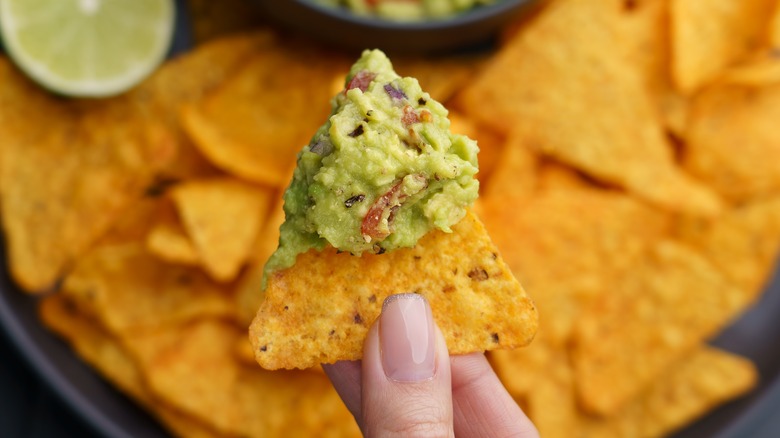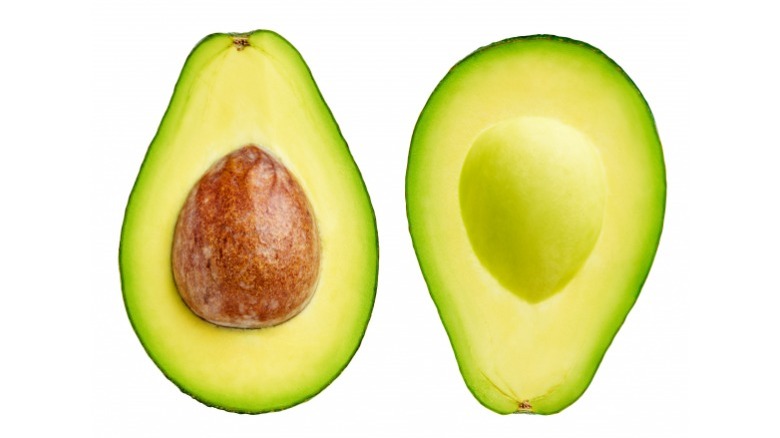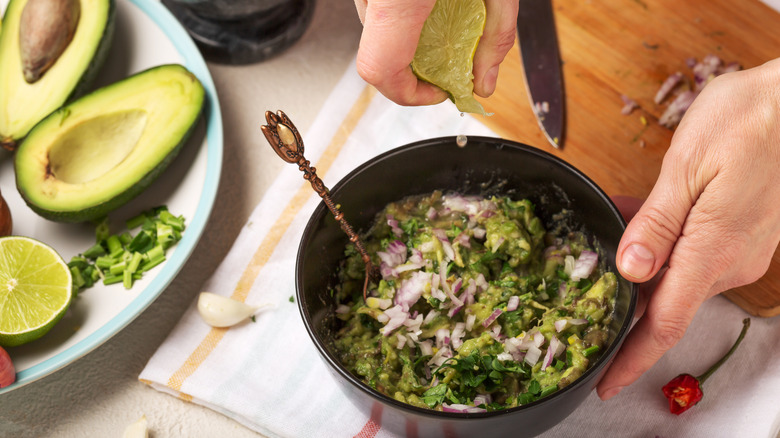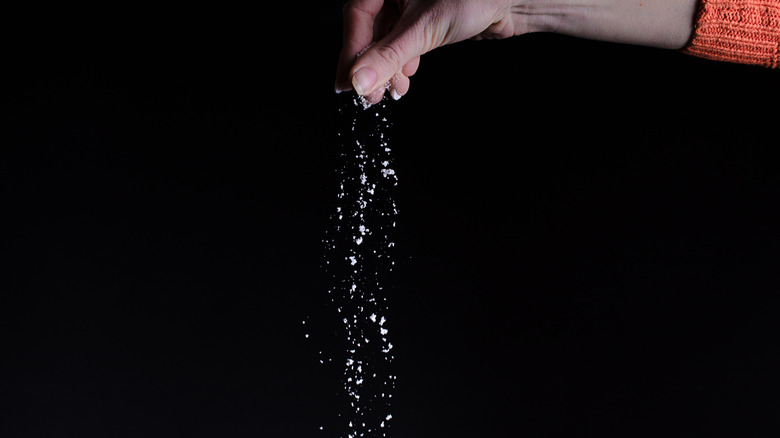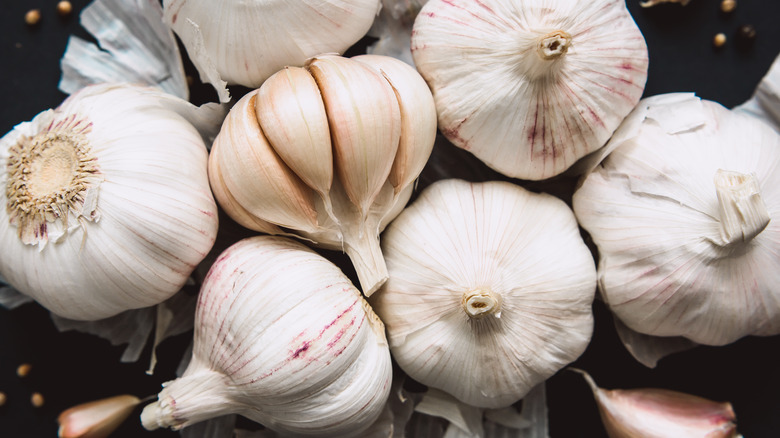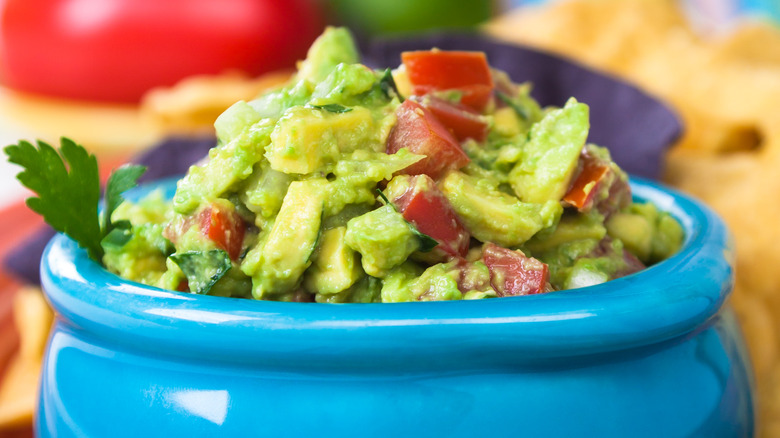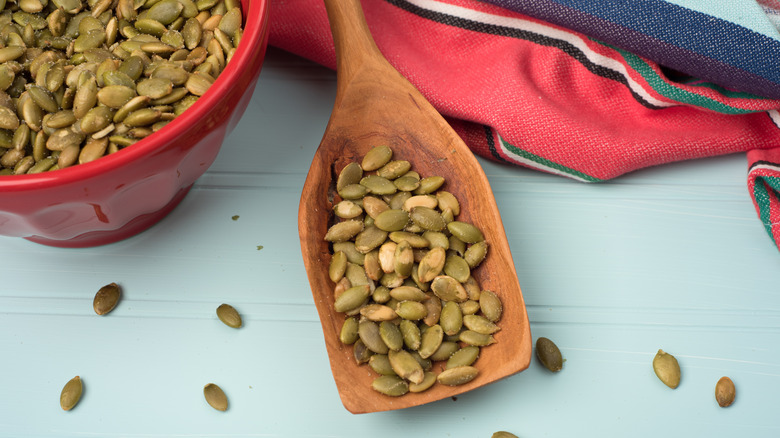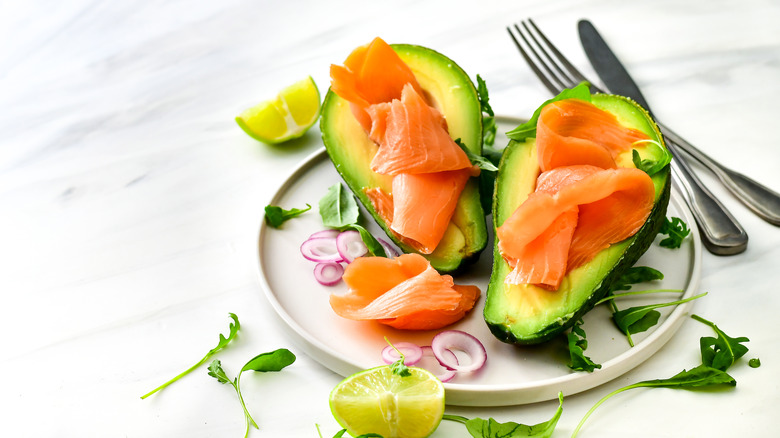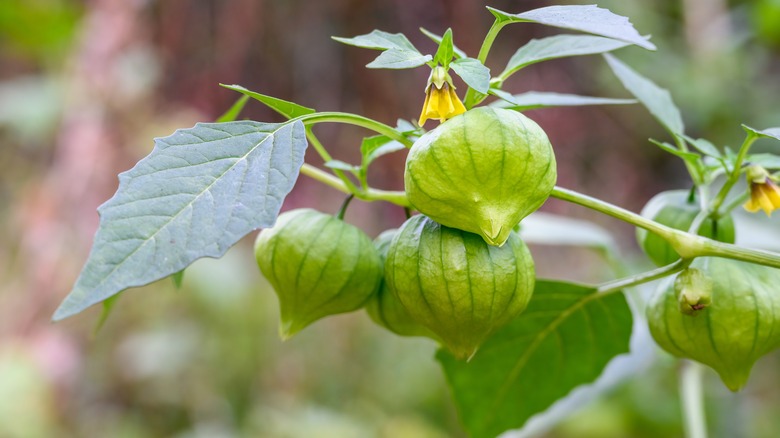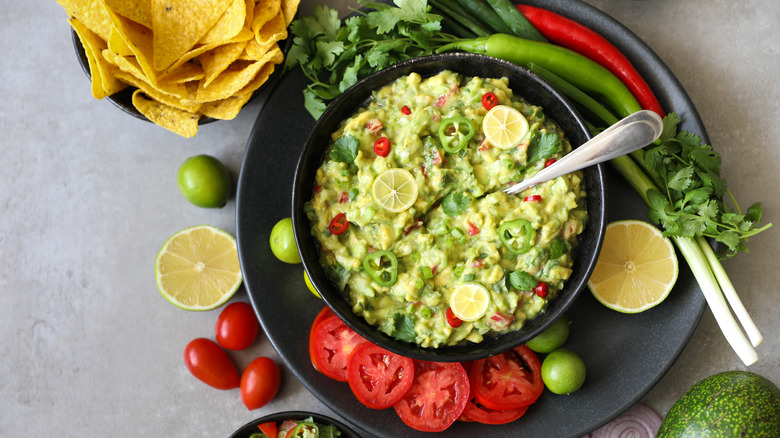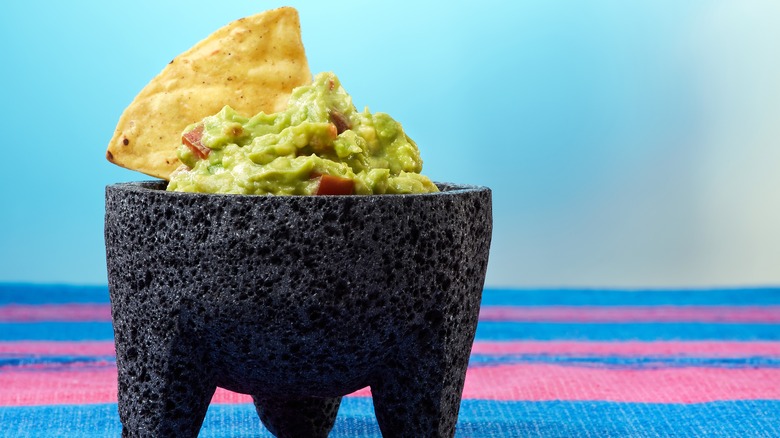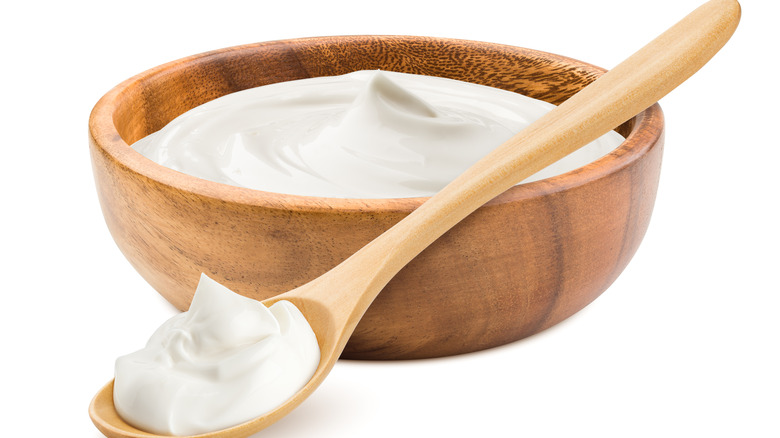12 Tips That Will Take Your Guacamole To The Next Level
Made with avocados, onions, lime juice, cilantro, chilies, salt, and sometimes tomatoes, guacamole is a crowd-pleaser that you really don't have to mess with. In fact, some people are so adamant about the purity of guacamole that they take a stand against including tomatoes. However, tomatoes are commonly found in traditional Tex-Mex guacamole recipes, giving them points for authenticity.
Putting tomatoes to one side, figuratively speaking, there are a few ways to undeniably ruin your homemade guacamole. One way to quickly ruin your guacamole is to use ingredients that aren't fresh. It's also a bad idea to make your guacamole days or even hours ahead of when you plan on serving it. This is because avocado flesh that is exposed to air turns brown and mushy, making your guacamole unappetizing.
In addition to avoiding crucial mistakes, there are a few simple things you can do to take your guacamole to the next level. It all starts with having perfectly ripe avocados and the right amounts of key ingredients. After that, there are a small number of additions and techniques that can truly elevate humble guacamole.
Use avocados with the perfect ripeness
Avocados are a vital part of guacamole, as they give it its defining flavor and texture. Therefore, you'll have a hard time taking your guacamole to the next level if you don't use perfectly ripe avocados. You can tell if an avocado is ripe by picking at the stem. If the stem doesn't come off easily, it isn't ripe. If you are able to get the stem off, and it is green underneath, then your avocado is perfectly ripe. If you get the stem off and it's brown underneath, your avocado is overripe and probably best used in recipes where it's not the defining ingredient.
If you're digging through a pile of avocados at your supermarket and can't find a ripe one, try looking at the bottom of the pile. As avocados ripen, they release ethylene gas, and this gas stimulates the ripening process, notes J. Kenji Lopez Alt on Instagram. Ethylene gas is heavier than air, so it will drift to the bottom of a pile of avocados. That's why ripe avocados can often be found at the bottom of a pile.
If you buy perfectly ripe avocados for guacamole but have a change of plans, there are a few ways to keep avocados fresh. The first thing you should do is pop them in the refrigerator, which slows the ripening process. You could also submerge them in water as a way to minimize their exposure to oxygen, which causes them to ripen.
Don't be afraid of squeezing those limes
Lime juice is an essential ingredient in guacamole, and many people add a tablespoon or so just to cut through the fattiness of the avocado. However, avocados can be pretty fatty, and the flesh can stand up to significant amounts of acid. So if you really like the taste of lime juice, go ahead and double or triple the amount listed in your favorite recipe. With enough lime juice, you can push your guacamole close to a margarita in terms of acidity. If you accidentally get a bit too heavy-handed with the lime juice, adding a bit of sugar to your guacamole can balance it out.
Going heavy on lime juice has the added bonus of helping to keep your guacamole green. When avocados are allowed to oxidize through exposure to air, they turn brown and mushy, which can make your homemade guacamole dip a lot less appealing. When you add a significant amount of acid and mix it thoroughly, it protects against this unwanted oxidation reaction, allowing your guacamole to stay green and attractive for much longer than a low-acid guac.
Add a good amount of salt
Salt brings out flavors from all your other ingredients, but the amount of fat in avocado flesh means it can absorb a lot of seasoning. Therefore, you should go full Salt Bae and use two or three large "chef's pinches" of salt for every four avocados in your guacamole, depending on personal taste. It's important to note that a "chef's pinch" isn't the amount of salt you can literally pinch between your thumb and forefinger. A chef's pinch involves using three fingers — the thumb, the index finger, and the middle finger — to grab enough salt for a significant dusting.
It's also important to use the correct salt. Skip the table salt and go for kosher or sea salt instead. Table salt has additives that can give your guacamole off flavors. Kosher salt is less processed than table salt and it has coarser grains, giving it less salinity than table salt. Made from evaporated seawater, sea salt is the least processed of the three and it does contain residual minerals that could affect the color or flavor of your guacamole. However, sea salt tends to have the most delicate flavor, and it's often used as a finishing salt.
Cover it with water before storing to prevent browning
One of the biggest considerations when making guacamole is keeping it from oxidizing and turning an unappetizing brown color. Adding a lot of acids, such as a few tablespoons of lime juice, can help to prevent this oxidation from happening. While it is effective, it significantly changes the flavor of the guacamole and that could be a problem for people who aren't big fans of lime. Many websites recommend taking plastic wrap and pressing it up against the guacamole to prevent exposure to air. However, it's almost impossible to create an airtight seal by hand, so this is an imperfect solution.
It might sound weird, but a better approach is to place a layer of water over the top of your guacamole, and then cover the container with plastic wrap. When you cover your guacamole with a thin layer of water, the liquid acts as a barrier against oxidation. You also don't have to worry about your guacamole getting watery, because it's mostly fat and vegetables that don't absorb water. Before serving, simply pour off the water and stir in any small amount of residual water.
Give it some zing with garlic
Although they might sound like the same thing, there is a difference between guacamole and avocado salsa. One of the biggest differences is consistency. With avocado as its base, guacamole is thick and spreadable. Avocado salsa has tomatillos as its base and, as a result, it's more of a runny condiment.
Although it's not the same as guacamole, avocado salsa highlights the brilliant combination of garlic and avocado. Minimalist guacamole recipes do not include this allium, and many people who grew up on Tex-Mex food will say that garlic doesn't belong in "authentic" guacamole. However, it can really elevate guacamole to the next level, especially if you're a fan of raw garlic. In addition to being a great pairing with avocado, garlic also goes well with other common guacamole ingredients like onions, cilantro, jalapeños, and even tomato. So go ahead and add garlic to your guacamole with confidence. If any purists question it, just tell them you made thick avocado salsa.
Make chopped guacamole
A lot of guacamole recipes call for puréing the ingredients into a creamy consistency, not unlike that of baby food. While there's nothing wrong with doing this, it goes against the prevailing idea that vegetables are best when they're minimally processed. So, if you want to take your guacamole to the next level, consider serving it in a bowl full of diced ingredients. In fact, serving a chunky consistency is a major guacamole tip from Food Network host Alton Brown.
Serving chopped guacamole has a few culinary benefits. First of all, it shows guests that you actually made the guacamole from scratch and didn't just scoop it out of a container. Second, a bowl full of purple-colored onions, red tomatoes, yellow-green avocado, green cilantro, and possibly red, yellow, or orange chilies just looks pleasing to the eye. Third, serving a bowl of chopped guacamole with a large fork for mashing gives people who are eating it more control over the consistency. If someone likes their guacamole to be the consistency of a purée, they can scoop it onto a small plate and mash it to their heart's content.
Add texture and flavor with toasted pumpkin seeds
Toasted pumpkin seeds are a traditional Mexican ingredient, and they do have a place in guacamole. Chopped finely, these seeds add a unique nutty dimension and a bit of crunchy texture, which can be useful if you don't plan on eating your guacamole with crunchy tortilla chips. But before your start toasting the seeds from your Halloween jack-o'-lantern, you should know there's a difference between those pumpkin seeds and the popular Mexican ingredient known as pepitas.
While Americans commonly carve Howden pumpkins and make pies from sugar pumpkins, pepitas are the product of Styrian pumpkins, which are grown for both their seeds and oil. These seeds have a thin edible membrane and can be eaten either roasted or raw. These seeds can be used in the same way as any other edible seed, but they are a common ingredient in different Mexican cuisines, and therefore, can evoke flavor profiles of the country in some contexts, just as the taste of sesame seeds can evoke Mediterranean cooking.
Add smoked fish for an unexpected element
When you think of ingredients for guacamole, smoked fish probably isn't at the top of your list, if it is at all. However, it's common to find avocado paired with smoked salmon in all kinds of dishes, from sushi rolls to avocado toast. There is a reason this pairing works so well: Fat from the avocado combines with the smoke and salt of the salmon to create a deep umami flavor. Avocado also has subtle vegetal flavors that nicely contrast with that deep umami flavor. When you add onions, lime juice, and chilies to the equation, they brighten up what would otherwise be a very rich-tasting dish.
The combination of smoked salmon and avocado also offers a number of health benefits. Both ingredients are rich in an omega-3 fatty acid called ALA, which is known to reduce cardiovascular disease, according to Healthline. On top of that, both salmon and avocado are great sources of healthy protein. While the combination of smoked salmon and avocado is a great one, you can also upgrade guacamole with smoked whitefish. For example, a "modern Mexican" restaurant in Cleveland called Momocho has featured a popular version of guacamole made with smoked trout (via YouTube).
Make it lighter and brighter with tomatillos
Because they are similar in appearance, tomatillos are often confused with green tomatoes. However, they are two very different fruits, and the former is a much better addition to guacamole than the latter. Green tomatoes can have a mild, slightly vegetal taste and might be sweet or sour. Tomatillos have an acidic kick and more pronounced flavors, making them a more worthwhile addition to guacamole. An easy way to tell the difference between a tomatillo and green tomato is to check the fruit's firmness. A green tomato will have a good amount of give to it, while a tomatillo will have a firmness that's closer to unripe stone fruit.
Before incorporating tomatillos in your guacamole, you need to prepare them. First, remove the papery husks if they are still attached. If the husk is resistant to peeling, then your tomatillo isn't sufficiently ripe. After the husks are removed, wash the tomatillos to remove any sticky residue that may have been left behind. Once your tomatillos are washed, you can dice them and add the chunks or puree them to give your guacamole a thinner consistency.
Stick with a few ingredients
In his final op-ed for his "The Minimalist" column in The New York Times, iconic food writer Mark Bittman wrote that a culinary compromise wasn't a dirty term. Instead, his minimalism column was dedicated to making cooking more accessible through the abridged use of technique, time, and ingredients. Basically, you can make really good food without a ton of fuss.
When you're looking to make guacamole, Bittman's minimalist rallying cry ought to be ringing in your ears. Choose one or two additional ingredients or techniques. That's it. Your guacamole will be better off for having too few ingredients than too many. Need another reason to take a minimalist approach to guacamole? Well, minimalist menus happen to be a major predicted trend for 2023. According to research from the National Restaurant Association, inflation is pushing restaurants to do more with less. So if you're experiencing sticker shock at the grocery store, jump on this current trend and stick to a limited ingredient list.
Use a molcajete
Made by cutting up ingredients and mixing them together, possibly mashing them, guacamole is a very primal dish that appears to have been developed by the ancient Aztecs. Although we aren't sure how guacamole was originally prepared, we suspect that it was a simple dish of mashed avocados. This is because a lot of ingredients in modern guacamole – including juice from Persian limes and onions brought by European settlers — weren't available to the Aztecs.
When the Aztecs were making their version of guacamole, they were likely smashing the ingredients using a molcajete, which is similar but slightly different from a mortar and pestle. Today, many people in the American Southwest and Mexico still use a molcajete to make guacamole because it's great for extracting every bit of flavor out of chilies and onions. If you are thinking about buying a molcajete, you should know that they require a bit of care before they're ready to use. Start by cleaning the surface of any loose bits of stone. Then, soak your molcajete and ice water for eight hours. Finally, you must repeatedly grind dry white rice into the bowl's surface until the rice bits remain clean and don't pull any grey color off the molcajete. After a quick wash, it's ready to use.
Keep it green with sour cream
Many people add sour cream to guacamole as a way to increase the creaminess and add a subtle tangy flavor. But sour cream also has a utilitarian appeal: It can prevent the guacamole from turning brown. Avocados turn brown as they are exposed to oxygen, and adding acid to them can prevent this oxidation reaction. Some people add a lot of lime juice to keep their guacamole from turning brown, but this can add a lot of sourness that some people might not be into.
Sour cream can keep your guacamole green, but there's a technique you need to use. Rather than mixing it in to prevent browning, as you would with lime juice, spread a layer of sour cream over the top of your guacamole so that it prevents exposure to air. Then, cover the bowl with plastic wrap. When you're ready to serve, mix the sour cream into your still-green avocados to add creaminess and a bit of sour tang.
